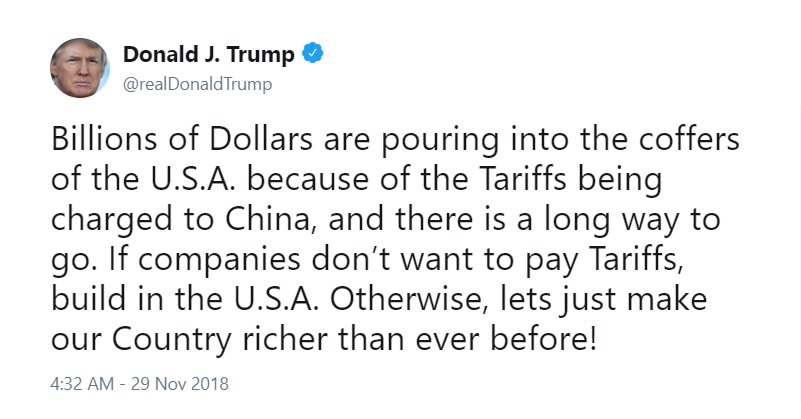Trump tweets that tariffs are making the US “richer than ever before.” They’re not.

Either President Donald Trump isn’t sure how tariffs work or he’s being deliberately misleading about them.
The president fired off an early-morning tweet on Thursday declaring that billions of dollars are “pouring into the coffers of the United States” because of the tariffs his administration has put on some $250 billion in Chinese imports.
“If companies don’t want to pay Tariffs, build in the U.S.A.,” Trump wrote. “Otherwise, lets just make our Country richer than ever before!”
Billions of Dollars are pouring into the coffers of the U.S.A. because of the Tariffs being charged to China, and there is a long way to go. If companies don’t want to pay Tariffs, build in the U.S.A. Otherwise, lets just make our Country richer than ever before!
— Donald J. Trump (@realDonaldTrump) November 29, 2018
But that’s not really how tariffs work: The US may be generating some revenue from tariffs, but billions of dollars aren’t pouring in. Moreover, a lot of the money that is made off of tariffs comes from US consumers — not Chinese companies.
“If you think about who’s actually paying the tax, it’s like a sales tax. It’s like saying, ‘I put a sales tax on producers, isn’t this great we’re getting all this money?’ And then consumers say, ‘Wait, that’s from my wallet,’” said Michael Klein, a professor of international economic affairs at the Fletcher School at Tufts University and founder of the nonpartisan economics publication Econofact. “It’s just another example of taking where there’s a tiny germ of truth and blowing it up to the point where it’s absurd, for his own political purposes.”
On Thursday, Trump will travel to Buenos Aires for the G20 summit, where, among other agenda items, he’s expected to meet with Chinese President Xi Jinping for a working dinner to discuss the countries’ relations, including trade. The sit-down is seen as high-stakes, given that the US has placed nearly $250 billion in tariffs on Chinese goods and China has levied retaliatory tariffs of its own. The escalating trade war poses a threat to both nations’ economies.
Tariffs don’t really work this way
The Trump administration has shown itself to be pretty into the idea of tariffs. It’s put tariffs on steel and aluminum imports from multiple countries as well as on several billion dollars of Chinese goods. The way tariffs work is that the goods marked for tariffs face a border tax when they’re imported into the US.
As Vox’s Matt Yglesias recently explained, the US government with its initial rounds of China tariffs was careful to make sure the products it targeted had foreign-made alternatives:
When that happens, US purchasers switch to non-Chinese alternatives, and then consumers from outside the US tend to switch around and start buying the Chinese products. The overall impact is slightly less efficient global supply chains, some real pain to Chinese firms that need to find new customers, and a limited impact on American prices.
In other words, thus far, things have been relatively tame. A recent study from EconPol Europe found that Trump’s first round of tariffs have increased the prices US buyers pay for Chinese-made goods by 4.5 percent and decreased the prices received by Chinese sellers of US-bound goods by 20.5 percent.
That means that thus far, the tariffs have been mostly, but not entirely, paid for by China, but it’s not going great for anyone. And if Trump’s meeting with Xi doesn’t go well and the trade war escalates, the economic effects of tensions could worsen.
And it’s not going to be making the US significantly richer, because the more tariffs, the less incentive to import the goods affected, and therefore the less money being collected.
“If the point of tariffs is to reduce what you’re buying, that means you’re not going to make that much money,” Klein said.
And much of the money that does come in will be from Americans themselves. Tariffs are often passed on to consumers, therefore driving up prices and, ultimately, inflation.
Trump, who is personally very wealthy, has been rather cavalier about the potential for prices going up. In an interview with the Wall Street Journal this week in which he appeared to float the idea of putting tariffs on iPhones and laptops, he said, “I mean, I can make it 10 percent, and people could stand that very easily.”
“Made in the USA” isn’t as easy as Trump makes it out to be
President Trump often makes the case that many of the United States’ trade and economic problems could be solved if companies would just do all of their manufacturing here. He’s attacked General Motors, Apple, and Harley-Davidson, among others, for having operations outside the US.
But “build in America” (which, by the way, many of Trump’s companies didn’t) isn’t as easy as it sounds. Supply chains are global, so even when Trump thinks he’s hitting back at China over, say, the iPhone, he’s missing the fact that the product is sourced from a lot of places, and its supply chain spans many countries.
In an Econofact analysis last year, Klein and Harvard political economist Marc Melitz estimated that each iPhone 7 imported to the US was recorded as a $225 import from China, but of that amount, only $5 represents work performed in China, largely assembly. The remaining $220 corresponds to other parts of Asia, Europe, and the Americas.
“It always sounds good when a president sounds tough on trade and issues protectionist policies,” Wayne Lam, a principal analyst at the information and analytics firm IHS Markit, told me when discussing the iPhone earlier this year. “We just don’t have the sheer workforce size nor skill set to be good at consumer electronics manufacturing.”
[Vox]